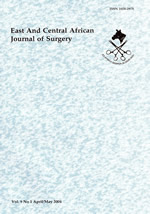
|
East and Central African Journal of Surgery
Association of Surgeons of East Africa and College of Surgeons of East Central and Southern Africa
ISSN: 1024-297X
EISSN: 1024-297X
Vol. 14, No. 2, 2009, pp. 13-17
|
 Bioline Code: js09028
Bioline Code: js09028
Full paper language: English
Document type: Research Article
Document available free of charge
|
|
|
East and Central African Journal of Surgery, Vol. 14, No. 2, 2009, pp. 13-17
| en |
Outcome of Management of Humerus Diaphysis Non-union
Sitati, F. C. & Kingori, J.
Abstract
Background
: The majority of diaphyseal humerus fractures heal uneventfully when treated non-operatively, however, nonunion is not a rare event. Nonunion after conservative treatment can be successfully treated by open reduction and internal fixation. A nonunion of a diaphyseal fracture of the humerus can present a major functional problem. The main of our study was to document the outcome of management of non united diaphyseal humerus fractures with plate or plate and rush pin fixation.
Methods
: A 4 year retrospective study was undertaken at Presbyterian Church of East Africa (PCEA) Kikuyu Hospital, Orthopedic Unit in Kenya from April 2004 to April 2008. Records of consecutive patients with nonunion of the humeral diaphysis were reviewed. Four cases were lost to follow up. The rest were treated with a single posterior, anterior or anterolateral plate while four with a plate and rush pin construct. Autogenous iliac crest bone graft was utilised in most of the cases. A clinical evaluation for union, range of motion and complications. Radiological assessment for union was also done.
Results
: A total of 46 patients with humerus diaphysis non union met the inclusion criteria. Their ages ranged from 23 to 95 years with a mean of 43.6 years. The overall healing rate was 92.8 % (39/42 cases) at 6 months follow up. 3 failures occurred of whom one was a smoker and diabetic, another had a loose plate and screws following replating. The third case went to nonunion. Three cases of postoperative radial nerve palsy all of which resolved within six weeks were documented. Allfour treated with a plate and rush pin construct healed uneventfully.
Conclusion
: The results of this study indicate that our standard surgical procedure for treatment of nonunion of the humeral shaft is reliable with a 92.8% union rate in our study with few complications. The plate and rush pin construct is useful in dealing with nonunion involving osteoporotic bone.
|
| |
© Copyright 2009 -Rural Outreach Program
|
|
